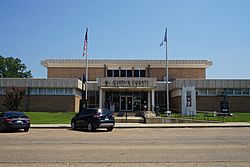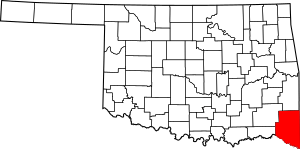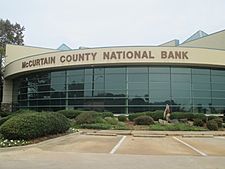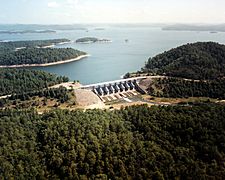McCurtain County, Oklahoma facts for kids
Quick facts for kids
McCurtain County
|
|
|---|---|

The McCurtain County Courthouse is located downtown in Idabel.
|
|

Location within the U.S. state of Oklahoma
|
|
 Oklahoma's location within the U.S. |
|
| Country | |
| State | |
| Founded | 1907 |
| Seat | Idabel |
| Largest city | Idabel |
| Area | |
| • Total | 1,902 sq mi (4,930 km2) |
| • Land | 1,850 sq mi (4,800 km2) |
| • Water | 52 sq mi (130 km2) 2.8%% |
| Population
(2010)
|
|
| • Total | 33,151 |
| • Estimate
(2019)
|
32,832 |
| • Density | 18/sq mi (7/km2) |
| Congressional district | 2nd |
McCurtain County is in the southeastern corner of the U.S. state of Oklahoma. As of the 2010 census, the population was 33,151. Its county seat is Idabel. It was formed at statehood from part of the earlier Choctaw Nation in Indian Territory. The name honors an influential Choctaw family that lived in the area. Green McCurtain was the last chief when Oklahoma became a state in 1907.
Contents
History
The area now included in McCurtain County was part of the Choctaw Nation before Oklahoma became a state. In the 1820s, it was a major part of Miller County, Arkansas. The area was sparsely populated, with no roads or bridges and no towns. There were post offices established at small trading posts along the various trails. Towns began to form when the Arkansas and Choctaw Railway (later the St. Louis and San Francisco Railway) was built across the area in 1902. Between 1910 and 1921 the Choctaw Lumber Company laid tracks for the Texas, Oklahoma and Eastern Railroad from Valliant, Oklahoma to DeQueen, Arkansas. These roads still served the area at the beginning of the 21st century.
Initially, the county experienced difficulty functioning because of lack of funds. When the Choctaws accepted their land allotments, their homesteads were not taxable for twenty-one years. No roads were built until a decade after statehood. There were no bridges, so ferries carried people and vehicles across the major streams.
Geography
According to the U.S. Census Bureau, the county has a total area of 1,902 square miles (4,930 km2), of which 1,850 square miles (4,800 km2) is land and 52 square miles (130 km2) (2.8%) is water. It is the third-largest county in Oklahoma by area. The terrain of McCurtain county varies from the foothills of the Ouachita Mountains in the northern part of the county to the rich Red River bottoms of the southern part. Sections of the Mountain Fork and Little River drainages lie in McCurtain county. Glover River originates in McCurtain County and flows 33.2 miles (53.4 km) to its confluence with Little River southeast of Wright City. Broken Bow Lake was created in 1968 by damming the Mountain Fork River. Mountain Fork river is one of the two year round trout fisheries in the state. The lowest point in the state of Oklahoma is located on the Little River in McCurtain County, where it flows out of Oklahoma and into Arkansas.
The county also contains McCurtain County Wilderness Area, a 14,087 acre tract created in 1918 and managed by the Oklahoma Department of Wildlife Conservation.
Major highways
 U.S. Highway 70
U.S. Highway 70 U.S. Highway 259
U.S. Highway 259 State Highway 3
State Highway 3 State Highway 4
State Highway 4 State Highway 37
State Highway 37 State Highway 87
State Highway 87 State Highway 98
State Highway 98
Adjacent counties
- Le Flore County (north)
- Polk County, Arkansas (northeast)
- Sevier County, Arkansas (east)
- Little River County, Arkansas (southeast)
- Bowie County, Texas (south)
- Red River County, Texas (southwest)
- Choctaw County (west)
- Pushmataha County (northwest)
National protected areas
- Little River National Wildlife Refuge
- Ouachita National Forest (part)
Demographics
| Historical population | |||
|---|---|---|---|
| Census | Pop. | %± | |
| 1910 | 20,681 | — | |
| 1920 | 37,905 | 83.3% | |
| 1930 | 34,759 | −8.3% | |
| 1940 | 41,318 | 18.9% | |
| 1950 | 31,588 | −23.5% | |
| 1960 | 25,851 | −18.2% | |
| 1970 | 28,642 | 10.8% | |
| 1980 | 36,151 | 26.2% | |
| 1990 | 33,433 | −7.5% | |
| 2000 | 34,402 | 2.9% | |
| 2010 | 33,151 | −3.6% | |
| 2019 (est.) | 32,832 | −1.0% | |
| U.S. Decennial Census 1790-1960 1900-1990 1990-2000 2010-2019 |
|||
At the 2000 census there were 34,402 people, 13,216 households, and 9,541 families in the county. The population density was 7/km2 (19/mi2). There were 15,427 housing units at an average density of 3/km2 (8/mi2). The racial makup of the county was 70.54% White, 9.30% Black or African American, 13.57% Native American, 0.22% Asian, 0.01% Pacific Islander, 1.34% from other races, and 5.02% from two or more races. 3.09%. were Hispanic or Latino of any race. 28.6% were of American, 7.6% Irish and 5.9% English ancestry. 94.4% spoke English, 2.9% Spanish and 2.6% Choctaw as their first language.
Of the 13,216 households 34.00% had children under the age of 18 living with them, 53.30% were married couples living together, 14.60% had a female householder with no husband present, and 27.80% were non-families. 25.40% of households were one person and 11.00% were one person aged 65 or older. The average household size was 2.56 and the average family size was 3.06.
The age distribution was 28.20% under the age of 18, 8.30% from 18 to 24, 26.20% from 25 to 44, 23.40% from 45 to 64, and 14.00% 65 or older. The median age was 36 years. For every 100 females there were 92.80 males. For every 100 females age 18 and over, there were 89.10 males.
The median household income was $24,162 and the median family income was $29,933. Males had a median income of $26,528 versus $17,869 for females. The per capita income for the county was $13,693. About 21.00% of families and 24.70% of the population were below the poverty line, including 32.40% of those under age 18 and 21.20% of those age 65 or over.
Communities
Cities
- Broken Bow
- Idabel (county seat)
Towns
Census-designated place
Other unincorporated communities
Economy
Agriculture and forestry have dominated the county's economy. The dense forests that originally covered the area were cleared and processed within two decades after statehood. The cleared lands then became subsistence farms. Cotton was the main money crop, until the cotton market collapsed during the Great Depression. Cattle raising, as well as production of swine and poultry, replaced cotton farming in importance. Cotton farms in the Red River valley began raising grains and forage instead.
Natural reseeding and active reforestation projects, both public and private, have replenished much of the harvested forest area. This revitalized the timber industry, which is again important to the county economy.
Limestone, sand and gravel are extracted for extensive local use.
Images for kids
See also
 In Spanish: Condado de McCurtain para niños
In Spanish: Condado de McCurtain para niños




